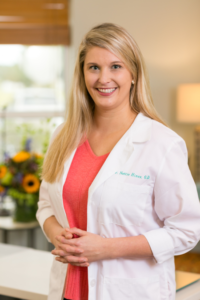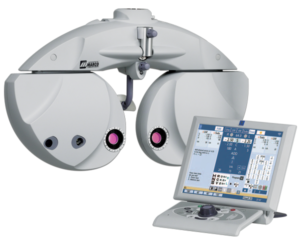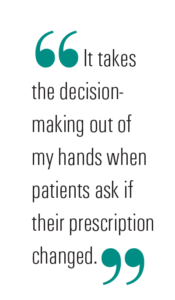

While she offers a full range of primary eye care services, she’d be happiest if she could focus solely on dry eye and specialty lenses. The optometric community in town has been very happy to refer scleral lens patients to her.
“The patients appreciate being able to come here for the service, and then they return to their primary eye care provider for their routine care,” she says.
TOPOGRAPHY FOR ALL PATIENTS
Before she opened, she attended the International Congress of Scleral Lenses held in Fort Lauderdale, Florida, in 2019. There she met a representative from Marco and “we discussed the importance of getting topography on all my patients, and I was so impressed by the Marco technology,” she says.
She purchased the brand new TRS-6100 as well as the OPD-Scan III (OPD3) and LM-7. “I had worked with the TRS-5100 previously, but the 6100 is more user-friendly and integrates well with my practice management system,” she says. Initially, she was leaning toward doing manual refractions, but she’s thrilled that she made the leap to this technology.
Every patient who comes into the practice for a comprehensive eye exam has the OPD3 scan done. “As a result, I’m able to break apart the individual components of the optical system, which is key to making an assessment,” she says.


SETTING EXPECTATIONS
Before dilation, she completes the refraction. The results from the OPD3 help her determine if there are ocular surface issues that might impact what the ultimate endpoint will be. “I can tell patients, ‘This is what I can correct.’ If there are internal issues with the eye, I can set the bar so that patient isn’t disappointed. ‘You have cataracts that I’m watching, but as a result, this is what I’ll be unable to correct.’”
The OPD3 also lets her know when she is likely to get the patient to 20/20 rather easily. “I can use the autoJCC with split prism in the TRS-6100. It utilizes what I do in a normal refraction and determines the astigmatism axis and power. Rather than asking patients which is better, I can show them simultaneous comparisons so that they can look at the right and left images and tell me. It’s super helpful in fine-tuning the prescription,” she says.
Each day, she says she is learning more about the TRS-6100. “I’m having fun seeing what it can do. As soon as I get comfortable with a procedure, I want to start taking it to the next level.”
Dr. Hines outfitted one of her two exam lanes with the Marco equipment. “Refraction is the lifeblood of what we do,” she says, and she finds it so interesting. A physics major in undergraduate school, she has always been interested in optics and the different techniques eye care professionals can use to achieve better vision. “Medical and specialty services may be the way of the future, but the first step in eye care is to complete a thorough medical exam. The OPD3 allows me to see how clean the optical system is, and then the TRS allows me to identify the endpoint quickly and effectively,” she says.
INCREASING SALES


Her ability to flip between a night and day prescription with the OPD3 is also very helpful. “I can show patients that the prescription for nighttime, with a dilated pupil, is a little different. ‘Maybe it’s worth it to consider a pair of night-time driving eyeglasses.’” The OPD3 also allows her to simulate the patient’s vision with single vision, bifocal, progressive and computer progressive lenses.
The more educated her patients are about the advantages that different eyewear can provide, the more interested they are in achieving the best visual function and comfort for their diverse demands.



